Abstract
As a result of the advancement in the fourth industrial revolution and communication technology, the use of digital twins (DT) and federated learning (FL) in the industrial Internet of Things (IIoT), the Internet of Vehicles (IoV), and the Internet of Drones (IoD) is increasing. However, the deployment of DT and FL for IoV is challenging. In this survey, we focus on DT and FL for IIoT, IoV, and IoD. Initially, we analyzed the existing surveys. In this paper, we present the applications of DT and FL in IIoT, IoV, and IoD. We also present the open research issues and future directions.
1. Introduction
The fourth industrial revolution revolutionized the Internet of Things (IoT). This age of the industrial revolution is also called the connected age [1]. The industrial revolution started in 1780 with the introduction of the mechanization age. In 1870, the second revolution, named the electrification age, was introduced. As a result of the advancement in technology, Industry 3.0, also known as the automated age, was adopted in 1970. However, with the introduction of IoT, Industry 4.0, also called the connected age, was fully utilized. Because of increased interconnection and smart automation, Industry 4.0 envisions a fast change in technology, industries, and social patterns and processes [2]. Industry 4.0, in essence, is the trend toward automation and data sharing in manufacturing technologies and processes such as cognitive computing [3], cyber–physical systems (CPSs) [4], the industrial Internet of Things (IIoT) [5], cloud computing [6], indoor factories [7], IoT, and artificial intelligence (AI). Figure 1 shows the evolution of the industrial revolution.

Figure 1.
Industrial revolution from Industry 1.0 to Industry 4.0.
Industry 4.0 uses technologies such as DT and FL. DT is the digital processing and evaluation of an industry, smart city, or network. Intelligent manufacturing is composed of six layers; the zero layer is called the manufactory area; the first layer is known as the manufactory building; the second layer is infrastructure; the third layer is operations the fourth layer is the smart manufactory; and the fifth layer is DT [8]. All these layers are shown in Figure 2.
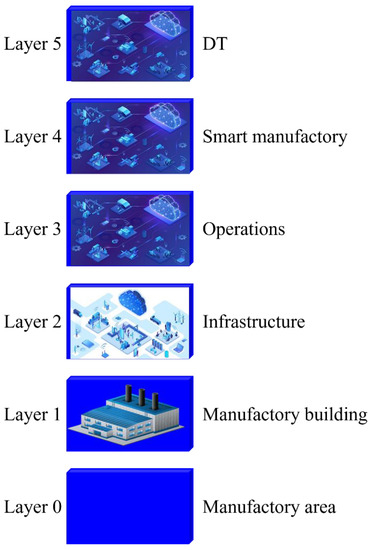
Figure 2.
Different layers of intelligent manufacturing having DT. Simulations and DT are two different things.
1.1. Simulations
Across industries, simulations are used to test goods, systems, processes, and concepts. Simulations are generally digital models created with computer-aided design software tools and are frequently utilized during the design phase. These models can be constructed in 2D or 3D to depict different aspects of a process or product, but they can also be created with mathematical principles rather than computer-based representations. To analyze results, the simulation introduces and tests many factors in the digital world or interface.
1.2. Digital Twins (DT)
A virtual representation that is constructed to accurately mirror an existing physical thing is referred to as a DT. The physical thing is outfitted with sensors that generate data regarding many elements of the device’s performance, such as on a wind turbine. This information is subsequently sent to a processing system and applied to the digital model. This DT may then be used to run simulations, analyze current performance, and create prospective enhancements that can be transferred back to the real asset. A DT for non-physical processes and systems may also be developed, replicating the underlying process or system, and allowing simulations to be undertaken using real-time data.
DT data is often obtained via Internet of Things (IoT)-connected devices, enabling the gathering of high-level information that can subsequently be merged into the virtual model.
A DT is essentially a virtual environment in which ideas may be explored with little constraints. With an IoT platform, the model transforms into an integrated, closed-loop twin that can be utilized to inform and drive company strategy.
1.3. Differences between Simulations and DT
Although both simulations and DT employ digital models to imitate items and processes, they have some fundamental distinctions. The most noticeable is that a DT generates a virtual environment capable of studying several simulations, supported by real-time data and a two-way communication flow between the twin and the sensors that gather this data. This improves the accuracy of predictive analytical models, allowing for better management and monitoring of products, regulations, and processes. A comparison of simulations and DT is presented in Table 1.

Table 1.
Comparison of simulations and DT.
1.4. Federated Learning (FL)
FL is defined as collaborative ML without centralized training data. In FL, the shared prediction model learns collaboratively and keeps all training data on the local devices, without storing all the information on a single server. FL provides several advantages, such as smarter models, low latency, less power consumption, and privacy preservation. FL is a new technology that enables phones to learn from other devices while keeping data private and secure. It works as follows. First, the phone downloads a generic ML model. Then, the phone personalizes and improves its model, and computes a summary of the changes. Thousands of summaries are anonymously combined when phones are plugged in at night. This provides a global improvement to the model, enabling it to work better for all users. Thus, users benefit from having a smarter phone, and their data remain in users’ hands [8]. Figure 3 demonstrates FL.
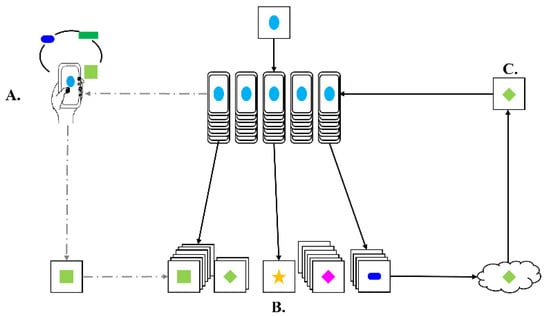
Figure 3.
Smart phone personalizes the model locally, based on usage (A). Many users’ updates are aggregated (B) to form a consensus change (C) to the shared model, after which the procedure is repeated.
1.5. IIoT
The industrial Internet of Things (IIoT), Internet of Vehicles (IoV), and Internet of Drones (IoD) are three important technologies of next generation networks (NGNs). IIoT is referred to as the industry of the future. IIoT refers to interconnected instruments, devices, and sensors networked with industrial applications on computers, such as for production and energy management. This connectivity enables data gathering, sharing, and analysis, possibly promoting productivity and efficiency increases and other economic benefits [9]. The IIoT is a development of a distributed control system (DCS) [10] that enables more automation by refining and optimizing process controls utilizing cloud computing.
1.6. IoV
IoV is a network of vehicles and allows the utilization of data generated by linked automobiles and Vehicular Ad Hoc Networks (VANETs). IoV is a decentralized network of vehicles outfitted with sensors, software, and technologies linking and exchanging data over the Internet following agreed-upon standards [11,12]. IoV emerged from Vehicular Ad Hoc Networks [13] (“VANET,” a type of mobile ad hoc network used for communication between automobiles and roadside equipment), and is predicted to grow into an “Internet of autonomous vehicles” in the future. The IoV is predicted to be one of the facilitators of autonomous, connected, shared, and electric (ACES) Future Mobility [14]. Figure 4 shows an illustration of the IoV.
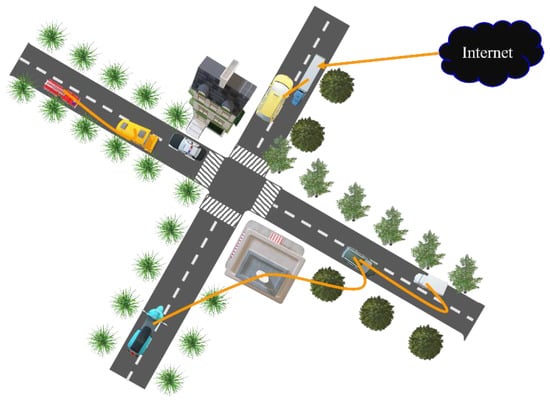
Figure 4.
Illustration of the IoV.
1.7. Internet of Drones (IoD)
The IoD is defined as an infrastructure that aims to offer control and access to drones and users over the Internet. Drones are quickly becoming commonplace commodities, allowing each user to fly many missions in regulated airspace. The IoD is a layered network control architecture developed primarily to coordinate the access of unmanned aerial vehicles (UAVs) to regulated airspace and deliver navigation services between nodes [15]. The IoD offers general services for various drone applications, including package delivery, traffic monitoring, and search and rescue [16,17,18]. Figure 5 illustrates the IoD.
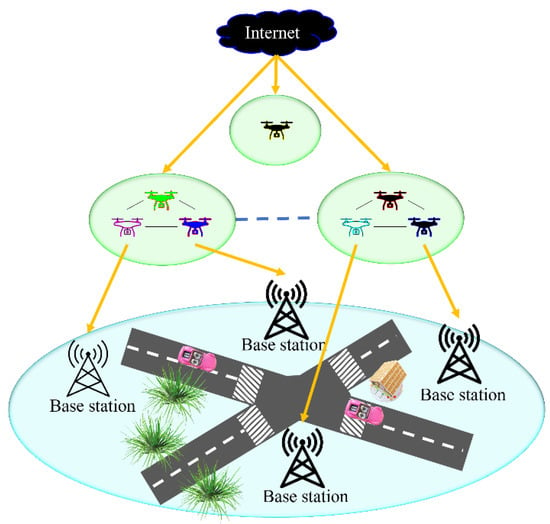
Figure 5.
Illustration of IoD.
1.8. Dawn of DT and FL
DT is the visual representation of an object in the digital world of the metaverse. It is updated from real-time data and uses simulation, ML, and reasoning to help decision making. The concept of the DT was introduced in 2002 for product lifecycle management. Since the introduction of this concept, it has been applied to diverse fields. During the past decade, the use of DT has increased significantly. Figure 6 shows the yearly trend of DT articles.
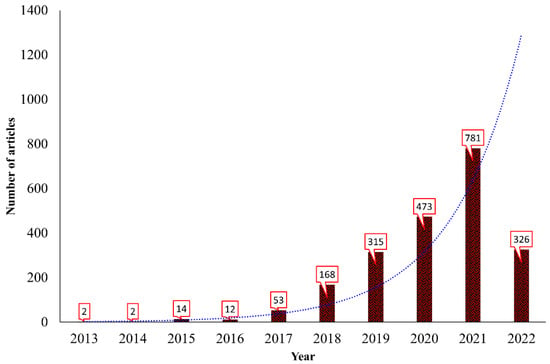
Figure 6.
Number of articles on DT on Google Scholar versus year (accessed on 21 May 2022).
A FL platform is a data science system developed for dispersed and, hence, non-centralized data. FL approaches enable enterprises to utilize their data together to cooperatively train ML models without explicitly sharing or centralizing their data. FL was first introduced and used by Google in 2016. Subsequently, it has been widely used in different fields of research. Figure 7 shows the yearly trend of FL articles on Google Scholar.
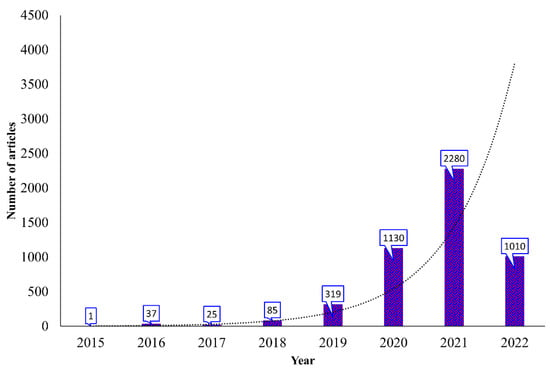
Figure 7.
Number of articles on FL on Google Scholar versus year (accessed on 21 May 2022).
1.9. Article Selection Criteria
We searched for articles for the survey in Google Scholar, Institute of Electrical and Electronics Engineers (IEEE) Xplore, ScienceDirect, and PubMed. Then we applied certain criteria to select articles to include in the survey. Figure 8 shows the flow chart of the selection criteria.
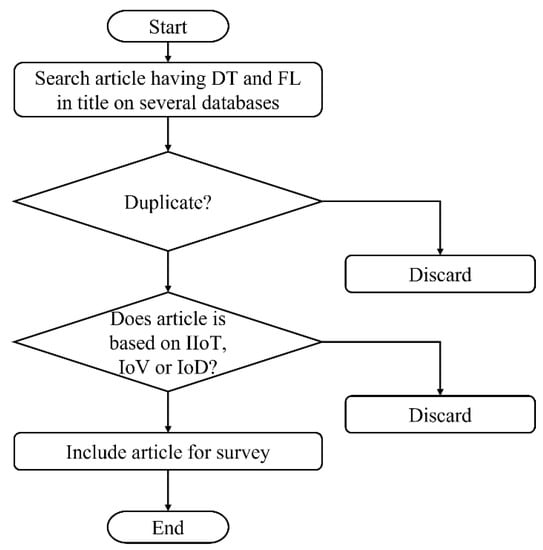
Figure 8.
Flowchart of the article selection criteria.
The use of DT and FL is increasing in the IIoT, IoV, and IoD. In this survey, we analyzed several applications of DTs and FL to the IIoT, IoV and IoD. The survey is organized as follows: Section two presents the discussion about the existing surveys on DT and FL. Section three presents the application of DT and FL to the IIoT, IoV, IoD. In section Four, the open research issues and future directions are explained. Section Five concludes the survey. The organization of the survey is shown in Figure 9.
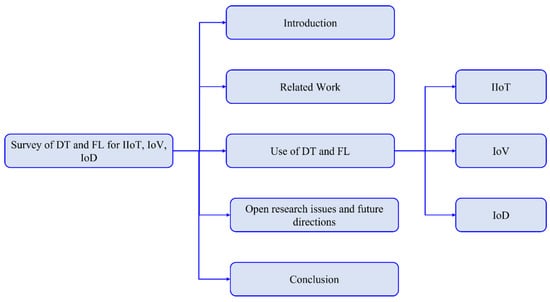
Figure 9.
Organization of the survey.
2. Related Work
DT and FL are used for several purposes. In the literature, there are a plethora of surveys discussing the application of DT and FL for healthcare, smart cities, next-generation networks, etc. In [19], the authors presented a comprehensive survey of DT’s definition, use cases, applications, and challenges. This survey lacked information about FL. Another study [20] surveyed the applications, advantages, and challenges of using DT in networks. However, FL was not included in the scope of the survey.
Lim et al. reviewed the use of DT for the innovative purpose of businesses, the advancement of businesses using DT, and the challenges of using DT in businesses. However, the survey lacked a discussion about DT and FL for Industry 4.0 [21].
Minerva et al. reviewed the DT application in IoT. The survey presented detailed information on DT use cases, issues, and challenges in IoT. However, the survey lacked analysis of the use of DT and FL in IoV and IoD [22].
Gámez Díaz et al. explained the use of DT in the ecosystem. The survey analyzed the deployment of DT in sports. The survey only focused on the DT deployment in the ecosystem [23].
Löcklin et al. reviewed the DT in autonomous industrial systems (AISs). The authors explained the effectiveness of using DT for the verification and validation of AISs. The survey encompassed IIoT but did not discuss FL. Moreover, the article did not explicitly discuss IoV and IoD [24].
Liu et al. surveyed the implementation of DT in IoT. They presented a comprehensive analysis of the techniques for the deployment of DT and the challenges faced during the implementation of DT in IoT. The survey did not address DT and FL for IoV and IoD [25].
Similarly, the surveys [26,27,28] presented the use of DT in the automotive industry, prognostics, and healthcare management (PMH), and Industry 4.0 as cyber–physical systems (CPSs), respectively. However, these surveys lacked a discussion of FL for IoV and IoD.
Zeb et al. reviewed the industrial DT at the nexus of the NGN and computational intelligence. The authors analyzed the use of DT in CPSs and NGNs. The authors also discussed the age of information (AoI). However, there is no information about IoV and IoD in this review [29].
Billah et al. surveyed the implementation of FL for blockchain-enabled IoV. They analyzed the importance of FL and the challenges faced during its deployment. However, the survey did not include DT [30].
Arora et al. explained the use of DT for IoD. The authors focused on the techniques and challenges of using DT in IoD. However, this survey did not address the use of DT and FL for IIoT and IoV [31].
Zhang et al. discussed the definition, technologies, security, privacy, and challenges of FL. The survey lacked information about IIoT, IoV, and IoD [32]. Similarly, the authors of [33] focused on FL for enabling technologies. The authors of [34,35,36,37] focused on data privacy and security using FL. Nguyen et al. discussed FL in IoT [38]. Lim et al. demonstrated the applications and challenges of FL in mobile edge networks [39].
Liu et al. surveyed the evolution of FL from distributed machine learning (ML) [40]. Imteaj et al. focused on FL for resource-constrained IoT devices [41]. Pham et al. surveyed the techniques and challenges in integrating FL and IIoT [42]. Kantaros et al. reviewed the implementation of DT for 3D printing. Moreover, they also presented the limitations [43]. Similarly, Singh et al. examined the development of DT. They provided insights into the origin and future of DT [44]. Costantini et al. demonstrated the implementation of IoT twins in Industry 4.0 [45]. All these surveys lacked discussion about DT, IoV, and IoD. Table 2 presents a comprehensive summary of the related surveys.

Table 2.
Summary of the existing literature works on DT and FL.
By analyzing Table 2, it is evident that no survey has simultaneously discussed the use of DT and FL for IIoT, IoV, and IoD. Thus, a survey is needed that discusses DT and FL for the IIoT, IoV, and IoD.
3. Use of DT and FL
This section explains the use of DT and FL for the IIoT, IoV, and IoD in the following subsections. The application of DT and FL has been proven to be efficient in increasing the performance of the IIoT, IoV, and IoD.
3.1. IIoT
DT is widely used in IIoT systems. Malakuti et al. elaborated on the definition of DT and the role of DT in IIoT systems. The authors also analyzed the decisions made by software architects regarding the architecture [46]. Similarly, the authors of [47] focused on the interoperability of DT for IIoT systems. The results showed that DT simulation of the development of the 3GPP for ultra-reliable low latency (URLLC) reduces the delay and increases reliability [48].
In [49], the authors proposed a DT model for basalt fiber production. They illustrated the smart digitization of the fiber industry using IIoT. Thomas et al. developed an artificial intelligence (AI) and extended reality (XR)-based DT for the management of complex systems. They also presented the advantages of using AI and XR for DT’s improved training and performance [50].
FL is also widely used for several purposes in IIoT networks. Zhang et al. demonstrated the data management by using a deep reinforcement learning (DRL)-based FL algorithm. The algorithm achieved 97% accuracy for the data management of the IIoT network [51]. Rahman et al. highlighted the importance of using FL to ensure the fairness and trustworthiness of the IIoT network [52].
Ferrag et al. presented a realistic dataset for cyber security. The dataset can be used for training FL models [53]. Jia et al. presented a blockchain-enabled FL scheme for protecting the data using differential privacy and homomorphic encryption [54].
Lakhan et al. presented deadline, latency, and energy-efficient strategies and a BEFC scheme to ensure blockchain hashing and validation [55]. Makkar et al. proposed SecureIIoT, an FL approach to avoid data breaches [56]. Similarly, the researchers demonstrated an FL and blockchain-enabled defensive transmission model and achieved 98% accuracy [57].
Vy et al. demonstrated federated transfer learning (FTL) for low computing power IIoT gadgets and achieved an accuracy of more than 70% for the KDD99 dataset [58]. In [59,60], the authors highlighted the use of FL for intrusion detection in context-aware IIoT networks and software-defined network (SDN)-enabled IIoT, respectively.
The researchers presented an FL-based cyber-threat hunting model for IIoT networks based on blockchain technology [61]. Chen et al. proposed a communication effective federated edge learning (FEL) algorithm for new radios in unlicensed spectrum (NRU)-based IIoT networks [62].
K et al. proposed a novel algorithm based on FTL for the authentication and privacy preservation of the IIoT network [63]. Table 3 presents the summary of the use of DT and FL in IIoT.

Table 3.
Summary of the use of DT and FL in IIoT.
3.2. IoV
DT and FL are also widely used in IoV for resource allocation, resource sharing, traffic prediction, etc. Hu et al. proposed a DT model to predict traffic data in an IoV network and improve accuracy and response time [64]. Similarly, the authors investigated DT for the dynamic resource allocation in an aerial-assisted IoV network [65].
Zhang et al. presented a DT model to evaluate and validate the charging recommendation design [66]. Tan et al. designed DT for remote resource sharing in IoV and applied a consortium blockchain to track and secure resource sharing [67]. Wang et al. proposed a DT model for efficient and quick resource sharing in an unmanned aerial vehicle (UAV)-based IoV network [68].
Several articles used FL in the IoV. Lu et al. presented an asynchronous FL approach to implement secure and effective data sharing in IoV networks [69]. Similarly, the researchers proposed a FL-based model for the improved TCP performance of the IoV network over WiFi [70].
Chai et al. proposed a blockchain-enabled FL algorithm for improved knowledge sharing in IoV networks [71]. Moreover, the authors proposed a novel FL model for efficient license plate recognition in 5G-enabled IoV [72].
Zhou et al. proposed a dual-layer FL and heterogeneous model aggregation for the efficient communication and privacy preservation of 6G-enabled IoV [73]. Kong et al. demonstrated FL-based cooperative positioning in the IoV network for autonomous driving and collision avoidance [74]. Wang et al. used FL for efficient resource management in the IoV network [75]. Table 4 shows a summary of the use of DT and FL in IoV networks.

Table 4.
Summary of the use of DT and FL in IoV.
3.3. IoD
The IoD is a network of drones. The use of FL, which is also known as collaborative learning, has proven to be very effective in the deployment of IoD. ML is used to supply numerous services in fog-affected IoDs, where vast amounts of training data are gathered by drones and evaluated in the nodes experiencing fog. Aggregating all data in these nodes may result in massive network traffic and data privacy leaks from drones. FL is therefore suggested to protect drone data privacy by performing local training in drones and communicating training model parameters to the fog-bound nodes without uploading raw drone data. However, ground eavesdroppers can still access private drones by eavesdropping and analyzing uploaded parameters during the FL training process. Yao et al. examined the power regulation of all drones to optimize the FL system security rate while considering drone battery capacities and quality of service (QoS) requirements (i.e., FL training time) [76].
Smart entities, such as smart automobiles having the ability to detect and act, are common in the modern day. During their operational period, these entities can collect a large amount of data, which can then be used to improve the well-being of inhabitants. However, these data are extremely sensitive, prompting concerns about privacy. Furthermore, network constraints, bandwidth use, and other factors may exacerbate the situation. FL, IoD, and dew computing (DC) are transformative technologies that may be used to address the aforementioned issues. Using IoD, a FL-based computing paradigm was implemented over DC to analyze road-related data in order to improve the efficiency of applications, such as for identifying parking places [77].
Similarly, Islam et al. used FL and IoD to create a blockchain-based data accumulation scheme. This scheme enhanced the security of IoD against cyber threats [78]. Zhang et al. investigated a robust semi-supervised learning-based FL scheme in IoD for automatic image recognition. The approach improved the privacy of the image data in the IoD [79]. Table 5 presents the summary of the use of FL in IoD.

Table 5.
Summary of the use of FL in IoD.
4. Open Research Issues and Future Directions
The use of DT and FL results in several open research issues, such as those relating to security, reliability, efficiency, privacy, and adaptability.
Data security is very important in the present era, and IIoT, IoV, and IoD produce massive amounts of data. These data are vulnerable to cyber threats, and the security of these data is very important. FL helps address this issue, but there is still a need to develop more robust techniques to resist cyber threats.
Similarly, the reliability of DT and FL is also an open research issue that needs to be addressed. DT and FL are considered more reliable; however, there is a need for schemes to address the reliability of DT and FL in the IIoT, IoV, and IoD.
DT provides a virtual model of the networks, and the efficiency of the network can be analyzed using DT. However, the real-time deployment of the same DT model can face the problem of efficiency. This opens a new pathway for researchers to develop models that address the efficiency of DT-based networks and real-time networks. Moreover, the IoD also lacks the use of DT.
Deployment of the DT network in the real world may face the problem of environmental adaptations. The same DT, which is more robust in the virtual world, may face a decline in performance when implemented in the real world.
DT and FL can be used for the resource allocation in the reconfigurable intelligence surface (RIS) based wireless network. Jamil et al. demonstrated the resource allocation in RIS based wireless network [80]. However, they have not used DT and FL which can be used to solve this problem more efficiently. Similarly, FL and DT can be used for the green communication. The techniques and challenges of the green communication are mentioned in [81].
There are several other challenges related to DT and FL, such as protocols and integration of DT and FL in networks. These issues provide future researchers with additional research directions.
5. Conclusions
DT and FL are emerging technologies that are widely used in the IIoT, IoV, and IoD. DT provides a virtual simulation of the networks, whereas FL involves collaborative learning and enhances the privacy and security of the network. In this survey, we discussed DT and FL, and the difference between DT and simulations. We presented the increasing trend in the DT and FL research. We analyzed the use of DT and FL in the IIoT, IoV, and IoD. We summarized several state-of the art studies using DT and FL for the IIoT, IoV, and IoD. We also showed that the deployment of DT and FL may present several open research challenges, such as those relating to security, privacy, efficiency, and adaptability. These open research issues provide insights for future researchers to address these problems.
Author Contributions
Conceptualization, S.J.; methodology, S.J.; validation, S.J. and M.R.; formal analysis, S.J.; investigation, M.R. and F.; writing—original draft preparation, S.J.; writing—review and editing, M.R. and F.; visualization, S.J.; supervision, M.R. and F. All authors have read and agreed to the published version of the manuscript.
Funding
This research received no external funding.
Institutional Review Board Statement
Not applicable.
Informed Consent Statement
Not applicable.
Data Availability Statement
Not applicable.
Conflicts of Interest
The authors declare no conflict of interest.
References
- Xu, X.; Lu, Y.; Vogel-Heuser, B.; Wang, L. Industry 4.0 and Industry 5.0—Inception, conception and perception. J. Manuf. Syst. 2021, 61, 530–535. [Google Scholar] [CrossRef]
- Ghobakhloo, M. Industry 4.0, digitization, and opportunities for sustainability. J. Clean. Prod. 2020, 252, 119869. [Google Scholar] [CrossRef]
- Chen, M.; Herrera, F.; Hwang, K. Cognitive computing: Architecture, technologies and intelligent applications. IEEE Access 2018, 6, 19774–19783. [Google Scholar] [CrossRef]
- Jazdi, N. Cyber physical systems in the context of Industry 4.0. In Proceedings of the 2014 IEEE International Conference on Automation, Quality and Testing, Robotics, Cluj-Napoca, Romania, 22–24 May 2014; pp. 1–4. [Google Scholar]
- Boyes, H.; Hallaq, B.; Cunningham, J.; Watson, T. The industrial internet of things (IIoT): An analysis framework. Comput. Ind. 2018, 101, 1–12. [Google Scholar] [CrossRef]
- Dang, L.M.; Piran, M.J.; Han, D.; Min, K.; Moon, H. A Survey on Internet of Things and Cloud Computing for Healthcare. Electronics 2019, 8, 768. [Google Scholar] [CrossRef] [Green Version]
- Jamil, S.; Rahman, M.; Tanveer, J.; Haider, A. Energy Efficiency and Throughput Maximization Using Millimeter Waves–Microwaves HetNets. Electronics 2022, 11, 474. [Google Scholar] [CrossRef]
- Hard, A.; Rao, K.; Mathews, R.; Ramaswamy, S.; Beaufays, F.; Augenstein, S.; Eichner, H.; Kiddon, C.; Ramage, D. Federated learning for mobile keyboard prediction. arXiv 2018, arXiv:1811.03604. [Google Scholar]
- Abuhasel, K.A.; Khan, M.A. A secure industrial Internet of Things (IIoT) framework for resource management in smart manufacturing. IEEE Access 2020, 8, 117354–117364. [Google Scholar] [CrossRef]
- Saad, A.A.; Faddel, S.; Mohammed, O. A secured distributed control system for future interconnected smart grids. Appl. Energy 2019, 243, 57–70. [Google Scholar] [CrossRef]
- Lee, E.K.; Gerla, M.; Pau, G.; Lee, U.; Lim, J.H. Internet of Vehicles: From intelligent grid to autonomous cars and vehicular fogs. Int. J. Distrib. Sens. Netw. 2016, 12, 1550147716665500. [Google Scholar] [CrossRef]
- Khelifi, A.; Abu Talib, M.; Nouichi, D.; Eltawil, M.S. Toward an Efficient Deployment of Open Source Software in the Internet of Vehicles Field. Arab. J. Sci. Eng. 2019, 44, 8939–8961. [Google Scholar] [CrossRef]
- Anwer, M.S.; Guy, C. A survey of VANET technologies. J. Emerg. Trends Comput. Inf. Sci. 2014, 5, 661–671. [Google Scholar]
- Adler, M.W.; Peer, S.; Sinozic, T. Autonomous, connected, electric shared vehicles (ACES) and public finance: An explorative analysis. Transp. Res. Interdiscip. Perspect. 2019, 2, 100038. [Google Scholar] [CrossRef]
- Abdelmaboud, A. The Internet of Drones: Requirements, Taxonomy, Recent Advances, and Challenges of Research Trends. Sensors 2021, 21, 5718. [Google Scholar] [CrossRef] [PubMed]
- Jamil, S.; Fawad; Rahman, M.; Ullah, A.; Badnava, S.; Forsat, M.; Mirjavadi, S.S. Malicious UAV Detection Using Integrated Audio and Visual Features for Public Safety Applications. Sensors 2020, 20, 3923. [Google Scholar] [CrossRef]
- Jamil, S.; Rahman, M.; Haider, A. Bag of Features (BoF) Based Deep Learning Framework for Bleached Corals Detection. Big Data Cogn. Comput. 2021, 5, 53. [Google Scholar] [CrossRef]
- Jamil, S.; Abbas, M.S.; Roy, A.M. Distinguishing Malicious Drones Using Vision Transformer. AI 2022, 3, 260–273. [Google Scholar] [CrossRef]
- Barricelli, B.R.; Casiraghi, E.; Fogli, D. A survey on digital twin: Definitions, characteristics, applications, and design implications. IEEE Access 2019, 7, 167653–167671. [Google Scholar] [CrossRef]
- Wu, Y.; Zhang, K.; Zhang, Y. Digital twin networks: A survey. IEEE Internet Things J. 2021, 8, 13789–13804. [Google Scholar] [CrossRef]
- Lim, K.Y.H.; Zheng, P.; Chen, C.H. A state-of-the-art survey of Digital Twin: Techniques, engineering product lifecycle management and business innovation perspectives. J. Intell. Manuf. 2020, 31, 1313–1337. [Google Scholar] [CrossRef]
- Minerva, R.; Lee, G.M.; Crespi, N. Digital twin in the IoT context: A survey on technical features, scenarios, and architectural models. Proc. IEEE 2020, 108, 1785–1824. [Google Scholar] [CrossRef]
- Gámez Díaz, R.; Yu, Q.; Ding, Y.; Laamarti, F.; El Saddik, A. Digital Twin Coaching for Physical Activities: A Survey. Sensors 2020, 20, 5936. [Google Scholar] [CrossRef] [PubMed]
- Löcklin, A.; Müller, M.; Jung, T.; Jazdi, N.; White, D.; Weyrich, M. Digital Twin for Verification and Validation of Industrial Automation Systems–a Survey. In Proceedings of the 2020 25th IEEE International Conference on Emerging Technologies and Factory Automation (ETFA), Vienna, Austria, 8–11 September 2020; Volume 1, pp. 851–858. [Google Scholar]
- Liu, Y.K.; Ong, S.K.; Nee, A.Y.C. State-of-the-art survey on digital twin implementations. Adv. Manuf. 2022, 10, 1–23. [Google Scholar] [CrossRef]
- Biesinger, F.; Kraß, B.; Weyrich, M. A Survey on the Necessity for a Digital Twin of Production in the Automotive Industry. In Proceedings of the 2019 23rd International Conference on Mechatronics Technology (ICMT), Salerno, Italy, 23–26 October 2019; pp. 1–8. [Google Scholar]
- Xiaodong, W.; Feng, L.; Junhua, R.; Rongyu, L. A survey of digital twin technology for PHM. In Recent Trends in Intelligent Computing, Communication and Devices; Springer: Singapore, 2020; pp. 397–403. [Google Scholar]
- Da Silva Mendonça, R.; De Oliveira Lins, S.; De Bessa, I.V.; De Carvalho Ayres, F.A., Jr.; De Medeiros, R.L.P.; De Lucena, V.F., Jr. Digital Twin Applications: A Survey of Recent Advances and Challenges. Processes 2022, 10, 744. [Google Scholar] [CrossRef]
- Zeb, S.; Mahmood, A.; Hassan, S.A.; Piran, M.J.; Gidlund, M.; Guizani, M. Industrial digital twins at the nexus of nextG wireless networks and computational intelligence: A survey. J. Netw. Comput. Appl. 2022, 200, 103309. [Google Scholar] [CrossRef]
- Billah, M.; Mehedi, S.; Anwar, A.; Rahman, Z.; Islam, R. A Systematic Literature Review on Blockchain Enabled Federated Learning Framework for Internet of Vehicles. arXiv 2022, arXiv:2203.05192. [Google Scholar]
- Arora, J.; Tushir, M. Digital Twin: Towards Internet of Drones. In Digital Twin Technology; CRC: Boca Raton, FL, USA, 2021; pp. 23–45. [Google Scholar]
- Zhang, C.; Xie, Y.; Bai, H.; Yu, B.; Li, W.; Gao, Y. A survey on federated learning. Knowl. Based Syst. 2021, 216, 106775. [Google Scholar] [CrossRef]
- Aledhari, M.; Razzak, R.; Parizi, R.M.; Saeed, F. Federated learning: A survey on enabling technologies, protocols, and applications. IEEE Access 2020, 8, 140699–140725. [Google Scholar] [CrossRef]
- AbdulRahman, S.; Tout, H.; Ould-Slimane, H.; Mourad, A.; Talhi, C.; Guizani, M. A survey on federated learning: The journey from centralized to distributed on-site learning and beyond. IEEE Internet Things J. 2020, 8, 5476–5497. [Google Scholar] [CrossRef]
- Mothukuri, V.; Parizi, R.M.; Pouriyeh, S.; Huang, Y.; Dehghantanha, A.; Srivastava, G. A survey on security and privacy of federated learning. Future Gener. Comput. Syst. 2021, 115, 619–640. [Google Scholar] [CrossRef]
- Li, Q.; Wen, Z.; Wu, Z.; Hu, S.; Wang, N.; Li, Y.; Liu, X.; He, B. A survey on federated learning systems: Vision, hype and reality for data privacy and protection. IEEE Trans. Knowl. Data Eng. 2021. [Google Scholar] [CrossRef]
- Yin, X.; Zhu, Y.; Hu, J. A comprehensive survey of privacy-preserving federated learning: A taxonomy, review, and future directions. ACM Comput. Surv. (CSUR) 2021, 54, 1–36. [Google Scholar] [CrossRef]
- Nguyen, D.C.; Ding, M.; Pathirana, P.N.; Seneviratne, A.; Li, J.; Poor, H.V. Federated learning for internet of things: A comprehensive survey. IEEE Commun. Surv. Tutor. 2021, 23, 1622–1658. [Google Scholar] [CrossRef]
- Lim, W.Y.B.; Luong, N.C.; Hoang, D.T.; Jiao, Y.; Liang, Y.C.; Yang, Q.; Niyato, D.; Miao, C. Federated learning in mobile edge networks: A comprehensive survey. IEEE Commun. Surv. Tutor. 2020, 22, 2031–2063. [Google Scholar] [CrossRef] [Green Version]
- Liu, J.; Huang, J.; Zhou, Y.; Li, X.; Ji, S.; Xiong, H.; Dou, D. From distributed machine learning to federated learning: A survey. Knowl. Inf. Syst. 2022, 64, 885–917. [Google Scholar] [CrossRef]
- Imteaj, A.; Thakker, U.; Wang, S.; Li, J.; Amini, M.H. A survey on federated learning for resource-constrained IoT devices. IEEE Internet Things J. 2021, 9, 1–24. [Google Scholar] [CrossRef]
- Pham, Q.V.; Dev, K.; Maddikunta, P.K.R.; Gadekallu, T.R.; Huynh-The, T. Fusion of federated learning and industrial Internet of Things: A survey. arXiv 2021, arXiv:2101.00798. [Google Scholar]
- Kantaros, A.; Piromalis, D.; Tsaramirsis, G.; Papageorgas, P.; Tamimi, H. 3D Printing and Implementation of Digital Twins: Current Trends and Limitations. Appl. Syst. Innov. 2022, 5, 7. [Google Scholar] [CrossRef]
- Singh, M.; Fuenmayor, E.; Hinchy, E.P.; Qiao, Y.; Murray, N.; Devine, D. Digital Twin: Origin to Future. Appl. Syst. Innov. 2021, 4, 36. [Google Scholar] [CrossRef]
- Costantini, A.; Di Modica, G.; Ahouangonou, J.C.; Duma, D.C.; Martelli, B.; Galletti, M.; Antonacci, M.; Nehls, D.; Bellavista, P.; Delamarre, C.; et al. IoTwins: Toward Implementation of Distributed Digital Twins in Industry 4.0 Settings. Computers 2022, 11, 67. [Google Scholar] [CrossRef]
- Malakuti, S.; Grüner, S. Architectural aspects of digital twins in IIoT systems. In Proceedings of the 12th European conference on software architecture: Companion proceedings, Madrid, Spain, 24–28 September 2018; pp. 1–2. [Google Scholar]
- Platenius-Mohr, M.; Malakuti, S.; Grüner, S.; Schmitt, J.; Goldschmidt, T. File-and API-based interoperability of digital twins by model transformation: An IIoT case study using asset administration shell. Future Gener. Comput. Syst. 2020, 113, 94–105. [Google Scholar] [CrossRef]
- Tan, J.; Sha, X.; Dai, B.; Lu, T. Wireless Technology and Protocol for IIoT and Digital Twins. In Proceedings of the 2020 ITU Kaleidoscope: Industry-Driven Digital Transformation (ITU K), Ha Noi, Vietnam, 7–11 December 2020; pp. 1–8. [Google Scholar]
- Golovatchev, J.; Kirchgeßner, G.; Bezlakovskii, A.; Bezalkovskii, E. Digital Twins for the Basalt Fiber Production 4.0: Smart Digitalization in the Fiber Industry through Industrial IoT (IIoT). In Proceedings of the 2021 International Conference on Engineering Management of Communication and Technology (EMCTECH), Vienna, Austria, 20–22 October 2021; pp. 1–6. [Google Scholar]
- Thomas, M.; Klenz, B.; Goodwin, P.R. How to use human and artificial intelligence with digital twins: Industrial Internet of Things (IIoT), artificial intelligence (AI), user interface technologies such as augmented reality and virtual reality can help the form and function of digital twins to improve training, operations and outcomes. Control. Eng. 2020, 67, 10–12. [Google Scholar]
- Zhang, P.; Wang, C.; Jiang, C.; Han, Z. Deep reinforcement learning assisted federated learning algorithm for data management of IIoT. IEEE Trans. Ind. Inform. 2021, 17, 8475–8484. [Google Scholar] [CrossRef]
- Ur Rehman, M.H.; Dirir, A.M.; Salah, K.; Damiani, E.; Svetinovic, D. TrustFed: A framework for fair and trustworthy cross-device federated learning in IIoT. IEEE Trans. Ind. Inform. 2021, 17, 8485–8494. [Google Scholar] [CrossRef]
- Ferrag, M.A.; Friha, O.; Hamouda, D.; Maglaras, L.; Janicke, H. Edge-IIoTset: A New Comprehensive Realistic Cyber Security Dataset of IoT and IIoT Applications for Centralized and Federated Learning. IEEE Access 2022, 10, 40281–40306. [Google Scholar] [CrossRef]
- Jia, B.; Zhang, X.; Liu, J.; Zhang, Y.; Huang, K.; Liang, Y. Blockchain-Enabled Federated Learning Data Protection Aggregation Scheme With Differential Privacy and Homomorphic Encryption in IIoT. IEEE Trans. Ind. Inform. 2022, 18, 4049–4058. [Google Scholar] [CrossRef]
- Lakhan, A.; Mohammed, M.A.; Kadry, S.; AlQahtani, S.A.; Maashi, M.S.; Abdulkareem, K.H. Federated Learning-Aware Multi-Objective Modeling and blockchain-enable system for IIoT applications. Comput. Electr. Eng. 2022, 100, 107839. [Google Scholar] [CrossRef]
- Makkar, A.; Kim, T.W.; Singh, A.K.; Kang, J.; Park, J.H. SecureIIoT Environment: Federated Learning empowered approach for Securing IIoT from Data Breach. IEEE Trans. Ind. Inform. 2022. [Google Scholar] [CrossRef]
- Zhang, P.; Hong, Y.; Kumar, N.; Alazab, M.; Alshehri, M.D.; Jiang, C. BC-EdgeFL: Defensive Transmission Model Based on Blockchain Assisted Reinforced Federated Learning in IIoT Environment. IEEE Trans. Ind. Inform. 2021, 18, 3551–3561. [Google Scholar] [CrossRef]
- Zhang, P.; Sun, H.; Situ, J.; Jiang, C.; Xie, D. Federated transfer learning for IIoT devices with low computing power based on blockchain and edge computing. IEEE Access 2021, 9, 98630–98638. [Google Scholar] [CrossRef]
- Vy, N.C.; Quyen, N.H.; Pham, V.H. Federated Learning-Based Intrusion Detection in the Context of IIoT Networks: Poisoning Attack and Defense. In Proceedings of the Network and System Security: 15th International Conference (NSS 2021), Tianjin, China, 23 October 2021; p. 131. [Google Scholar]
- Duy, P.T.; Van Hung, T.; Ha, N.H.; Do Hoang, H.; Pham, V.H. Federated learning-based intrusion detection in SDN-enabled IIoT networks. In Proceedings of the 2021 8th NAFOSTED Conference on Information and Computer Science (NICS), Hanoi, Vietnam, 21–22 December 2021; pp. 424–429. [Google Scholar]
- Yazdinejad, A.; Dehghantanha, A.; Parizi, R.M.; Hammoudeh, M.; Karimipour, H.; Srivastava, G. Block Hunter: Federated Learning for Cyber Threat Hunting in Blockchain-based IIoT Networks. IEEE Trans. Ind. Inform. 2022. [Google Scholar] [CrossRef]
- Chen, Q.; Xu, X.; You, Z.; Jiang, H.; Zhang, J.; Wang, F.Y. Communication-Efficient Federated Edge Learning for NR-U based IIoT Networks. IEEE Internet Things J. 2021. [Google Scholar] [CrossRef]
- Maurya, S.; Joseph, S.; Asokan, A.; Algethami, A.A.; Hamdi, M.; Rauf, H.T. Federated Transfer Learning for Authentication and Privacy Preservation Using Novel Supportive Twin Delayed DDPG (S-TD3) Algorithm for IIoT. Sensors 2021, 21, 7793. [Google Scholar]
- Hu, C.; Fan, W.; Zeng, E.; Hang, Z.; Wang, F.; Qi, L.; Bhuiyan, M.Z.A. Digital Twin-Assisted Real-Time Traffic Data Prediction Method for 5G-Enabled Internet of Vehicles. IEEE Trans. Ind. Inform. 2021, 18, 2811–2819. [Google Scholar] [CrossRef]
- Sun, W.; Wang, P.; Xu, N.; Wang, G.; Zhang, Y. Dynamic digital twin and distributed incentives for resource allocation in aerial-assisted internet of vehicles. IEEE Internet Things J. 2021, 8, 5839–5852. [Google Scholar] [CrossRef]
- Zhang, T.; Liu, X.; Luo, Z.; Dong, F.; Jiang, Y. Time series behavior modeling with digital twin for Internet of Vehicles. EURASIP J. Wirel. Commun. Netw. 2019, 1, 271. [Google Scholar] [CrossRef] [Green Version]
- Tan, C.; Li, X.; Luan, T.H.; Gu, B.; Qu, Y.; Gao, L. Digital Twin Based Remote Resource Sharing in Internet of Vehicles using Consortium Blockchain. In Proceedings of the 2021 IEEE 94th Vehicular Technology Conference (VTC2021-Fall), Norman, OK, USA, 27–30 September 2021; pp. 1–6. [Google Scholar]
- Wang, P.; Xu, N.; Sun, W.; Wang, G.; Zhang, Y. Distributed Incentives and Digital Twin for Resource Allocation in air-assisted Internet of Vehicles. In Proceedings of the 2021 IEEE Wireless Communications and Networking Conference (WCNC), Nanjing, China, 29 March–1 April 2021; pp. 1–6. [Google Scholar]
- Lu, Y.; Huang, X.; Zhang, K.; Maharjan, S.; Zhang, Y. Blockchain empowered asynchronous federated learning for secure data sharing in internet of vehicles. IEEE Trans. Veh. Technol. 2020, 69, 4298–4311. [Google Scholar] [CrossRef]
- Pokhrel, S.R.; Choi, J. Improving TCP performance over WiFi for internet of vehicles: A federated learning approach. IEEE Trans. Veh. Technol. 2020, 69, 6798–6802. [Google Scholar] [CrossRef]
- Chai, H.; Leng, S.; Chen, Y.; Zhang, K. A hierarchical blockchain-enabled federated learning algorithm for knowledge sharing in internet of vehicles. IEEE Trans. Intell. Transp. Syst. 2020, 22, 3975–3986. [Google Scholar] [CrossRef]
- Kong, X.; Wang, K.; Hou, M.; Hao, X.; Shen, G.; Chen, X.; Xia, F. A federated learning-based license plate recognition scheme for 5G-enabled internet of vehicles. IEEE Trans. Ind. Inform. 2021, 17, 8523–8530. [Google Scholar] [CrossRef]
- Zhou, X.; Liang, W.; She, J.; Yan, Z.; Kevin, I.; Wang, K. Two-layer federated learning with heterogeneous model aggregation for 6g supported internet of vehicles. IEEE Trans. Veh. Technol. 2021, 70, 5308–5317. [Google Scholar] [CrossRef]
- Kong, X.; Gao, H.; Shen, G.; Duan, G.; Das, S.K. FedVCP: A Federated-Learning-Based Cooperative Positioning Scheme for Social Internet of Vehicles. IEEE Trans. Comput. Soc. Syst. 2022, 9, 197–206. [Google Scholar] [CrossRef]
- Wang, G.; Xu, F.; Zhang, H.; Zhao, C. Joint resource management for mobility supported federated learning in Internet of Vehicles. Future Gener. Comput. Syst. 2022, 129, 199–211. [Google Scholar] [CrossRef]
- Yao, J.; Ansari, N. Secure federated learning by power control for Internet of Drones. IEEE Trans. Cogn. Commun. Netw. 2021, 7, 1021–1031. [Google Scholar] [CrossRef]
- Islam, A.; Shin, S.Y. FedRC: A Federated Learning-Based Roadside Computing Paradigm Through the Facilitation of Internet of Drones. In Proceedings of the 2021 International Conference on Information and Communication Technology Convergence (ICTC), Jeju Island, Korea, 20–22 October 2021; pp. 648–653. [Google Scholar]
- Islam, A.; Al Amin, A.; Shin, S.Y. FBI: A Federated Learning-Based Blockchain-Embedded Data Accumulation Scheme Using Drones for Internet of Things. IEEE Wirel. Commun. Lett. 2022, 11, 972–976. [Google Scholar] [CrossRef]
- Zhang, Z.; Ma, S.; Yang, Z.; Xiong, Z.; Kang, J.; Wu, Y.; Zhang, K.; Niyato, D. Robust Semi-supervised Federated Learning for Images Automatic Recognition in Internet of Drones. arXiv 2022, arXiv:2201.01230. [Google Scholar] [CrossRef]
- Jamil, S.; Rahman, M.; Abbas, M.S.; Fawad. Resource Allocation Using Reconfigurable Intelligent Surface (RIS)-Assisted Wireless Networks in Industry 5.0 Scenario. Telecom 2022, 3, 163–173. [Google Scholar] [CrossRef]
- Jamil, S.; Fawad; Abbas, M.S.; Umair, M.; Hussain, Y. A Review of Techniques and Challenges in Green Communication. In Proceedings of the 2020 International Conference on Information Science and Communication Technology (ICISCT), Karachi, Pakistan, 8–9 February 2020; pp. 1–6. [Google Scholar]
Publisher’s Note: MDPI stays neutral with regard to jurisdictional claims in published maps and institutional affiliations. |
© 2022 by the authors. Licensee MDPI, Basel, Switzerland. This article is an open access article distributed under the terms and conditions of the Creative Commons Attribution (CC BY) license (https://creativecommons.org/licenses/by/4.0/).